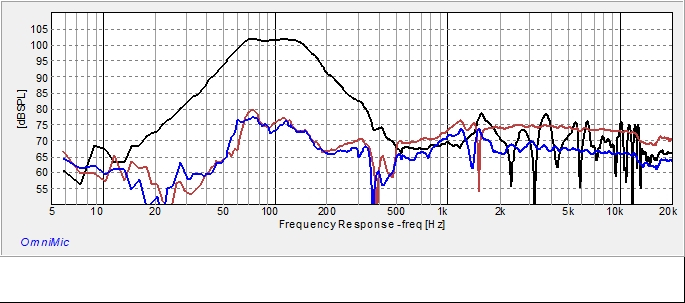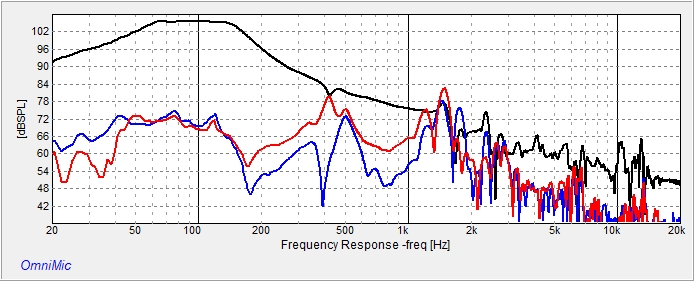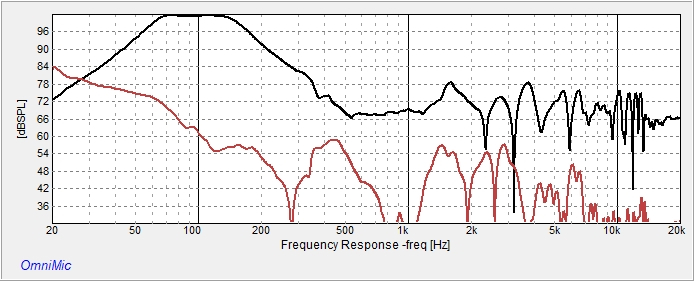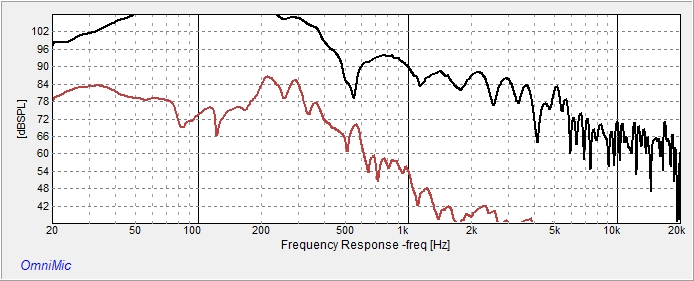Site Links
Howdy, Stranger!
It looks like you're new here. If you want to get involved, click one of these buttons!
Quick Links
Categories
In this Discussion
Who's Online (0)
sound transmission through the cabinet wall
I'm working on a small bandpass cabinet that uses a passive radiator instead of a port, and when I hooked it up to break in the driver I was struck by how much of the full spectrum of sound that I could hear at the back of the cabinet. We all know that there is leakage of frequencies outside of the band pass, but this didn't emanate from the PR, it was clearly coming from the cabinet walls. It's a small cabinet constructed mostly of 1/2" baltic birch plywood. Here's the measurements.Black is 1/4" from PR, Red is 1/4" off of the back of the cabinet directly behind the driver, Blue is 1/4" off the back of the cabinet 3/4 of the way up
This has got me thinking that my enclosures should all be of heroic construction.




Comments
That's a Bose secret, all that extra sound radiating into your room. Enclosure samosure!
Factoid: The latest 301's have the ports aimed literally at the back frame openings of the woofer👍🏻
Ahhhhh, the magic of Bose.
That 1/2 BB has excellent response I've swore off 1/2" anything since my Udique (original) build. I saw this in the distortion plots when you start cranking it up. I always cringe when Fitzy says all his prosound builds use 1/2"
I've swore off 1/2" anything since my Udique (original) build. I saw this in the distortion plots when you start cranking it up. I always cringe when Fitzy says all his prosound builds use 1/2"
The back panel is the largest panel unbraced at 6.75" ' 12" and radiating sound like crazy with only a 4" driver, so I have to wonder just how braced his cabinets are.
Maybe the entire box is moving? Could you add some mass to the top side and measure again? A small sand bag would be ideal... Something well damped, maybe a stack of books could work?
Unless you have a low pass filter on a bandpass you're going to hear a lot of bad stuff. With the full signal driving the woofer you're going to hear everything coming through the walls of the box and PR. I ran into this with a Sonotube bandpass I'm working on. Running it with a plate amplifier made it more than listenable. Measuring NF off the back panel what keeps you from picking up sound from the PR?
It's been a long time since I've built anything out of anything thicker than braced 1/2" Baltic birch everywhere but the front panel. That includes the Cherry Pi's. The black Formica Iron Driver entry I built was all 1/2" and the bandpass sub ran full range with no crossover. Everything was lined with 1" denim acoustic panels and the port was offset so it wouldn't be in front of the woofer.
The blue trace is the bandpass NF port measurement
Ron
You cannot brace too much.
The resonance looks good at 400Hz, 30dB down, right? But at 1K and 2K, it's only about 15 dB down from the driver output - that's got to be a problem. So that's the port resonances? I know Amir regularly finds problems like this in commercial speakers.
I will get some more measurements as soon as I can, the omni mic that I was using has an issue and I haven't calibrated the other one, so this weekend I'll try to get a measurement with weight on the enclosure and with the PR firing into another box stuffed with ultra touch in order to better isolate the front wave.
Are you not using a low pass filter with your bass cab?
After several hours, my mic is now calibrated, and here are the results with the bp box firing into another larger box filled with ultra tough for the rear measurements and my body weight on the bp enclosure for all of it. Just remember that these are quick and dirty, and not intended to be super accurate, just something that I found interesting.
The red is directly behind the driver, and the blue s about 3/4 of the way up the back.
Does it sound very different now?
Not much difference, and I know that it's down at least 20db, but I don't think that I will be making mid enclosures inside of 3 ways out of 1/2", unless they're covered in recycled rubber flooring material. At that point it's a 3/4" wall.
QFT!
QFT????
InDIYana Event Website
Quoted For Truth
My mind went: Quarter Frequency Tuned?
And the saga continues, but first a disclaimer. The results presented here are strictly for entertainment purposes and not intended to irritate, raise hackles or bunch panties......or are they? Anyway I measured the sound inside of the sealed and lined mid chamber using the same setup and volume level.
I have no way of knowing how much sound transmission was the physical contact of the mic to box. I also did a similar test on my Mnemosyne build, which uses much more heroic construction. the graph is once again mic close to the woofer and then close to the back wall.
Cross section of the wall construction.
Before anyone comments, yes the photo shows a high tech port plug.
Oh, just stuff a sock in it.
You should be able to wrap the mike in a thin neoprene sheet which will stop some direct transmission to the mike. Doesn't need to be perfect, just show a bit more S/N on the mid test.
How much of that sound can you actually feel being transmitted through the wall when you place the palm of your hand on those cabinet locations? (Impressive constrained layer construction) . . .
I guess sound transmission through the cabinet walls is much like XMax on a speaker - the floppier the cabinet wall, the larger its flexing and the lower the frequency that is transmitted and why thin sidewalls at high SPL's can actually cause a speaker cabinet to vibrate to the point of moving around on its placement surface.
The stiffer the cabinet walls the lower the vibration and higher the frequency . . .
So, how is it that polystyrene insulation board seems to be beneficial in speaker construction while it is very flexible and not very dense?